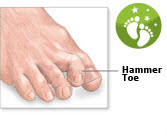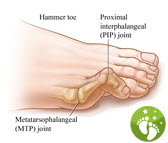Patients frequently come into the office complaining of a hammertoe or hammertoes. They often relate having problems wearing shoes, and/or express concern about a corn that has developed on one or more toes. A hammertoe is a contracted toe, and one in which the toe is no longer sitting straight or flat. Hammertoes can be genetic, and commonly occur in people with flat feet, or in people with a high-arched foot structure.
 Hammertoes can lead to the development of thick skin or corns on the toes. Additionally, hammertoes can place pressure on the bones in the ball of the foot, and result in calluses or cause pain in this area, which is a condition called metatarsalgia.
Hammertoes can lead to the development of thick skin or corns on the toes. Additionally, hammertoes can place pressure on the bones in the ball of the foot, and result in calluses or cause pain in this area, which is a condition called metatarsalgia.
Common treatment for hammertoes includes wearing offloading padding, shoes with a deep toebox, and orthotics which help to improve the faulty foot mechanics that lead to the development of hammertoe deformities. Your doctor can also pare/trim corns or calluses, which is important to alleviate pressure in the area.
It is important to keep a close eye on any areas of the foot with corns or calluses, because these represent areas of increased pressure, and if not treated, can result in an open wound or foot ulcer. In turn, an open wound or ulcer can lead to an infection.
 For patients in whom conservative treatment fails to adequately relieve pain, surgical treatment may be employed. However, I stress to all of my patients that surgery for hammertoes is the last treatment option, and it is also NOT necessary for most patients.
For patients in whom conservative treatment fails to adequately relieve pain, surgical treatment may be employed. However, I stress to all of my patients that surgery for hammertoes is the last treatment option, and it is also NOT necessary for most patients.
Hammertoes, however, can worsen or become more problematic over time. Give us a call to make an appointment to have your hammertoes evaluated, and to find out what treatment options are right for your individual situation. You may reach us at 586-298-1585.
